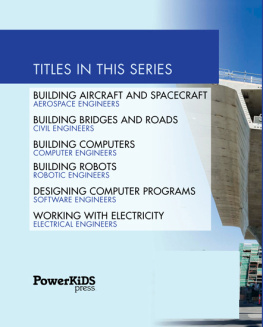
The author and publisher have provided this e-book to you for your personal use only. You may not make this e-book publicly available in any way. Copyright infringement is against the law. If you believe the copy of this e-book you are reading infringes on the authors copyright, please notify the publisher at: us.macmillanusa.com/piracy.
To Catherine
Though ours is an age of high technology, the essence of what engineering is and what engineers do is not common knowledge. Even the most elementary of principles upon which great bridges, jumbo jets, or super computers are built are alien concepts to many. This is so in part because engineering as a human endeavor is not yet integrated into our culture and intellectual tradition. And while educators are currently wrestling with the problem of introducing technology into conventional academic curricula, thus better preparing todays students for life in a world increasingly technological, there is as yet no consensus as to how technological literacy can best be achieved.
I believe, and I argue in this essay, that the ideas of engineering are in fact in our bones and part of our human nature and experience. Furthermore, I believe that an understanding and an appreciation of engineers and engineering can be gotten without an engineering or technical education. Thus I hope that the technologically uninitiated will come to read what I have written as an introduction to technology. Indeed, this book is my answer to the questions What is engineering? and What do engineers do?
The idea of designof making something that has not existed beforeis central to engineering, and I take design and engineering to be virtually synonymous for the purposes of my development. Examples from structural designs commonly associated with mechanical and civil engineers are most prominent in this book because it is from those fields that I draw my own experiences, but the underlying principles are no less applicable to other branches of engineering.
I believe that the concept of failuremechanical and structural failure in the context of this discussionis central to understanding engineering, for engineering design has as its first and foremost objective the obviation of failure. Thus the colossal disasters that do occur are ultimately failures of design, but the lessons learned from those disasters can do more to advance engineering knowledge than all the successful machines and structures in the world. Indeed, failures appear to be inevitable in the wake of prolonged success, which encourages lower margins of safety. Failures in turn lead to greater safety margins and, hence, new periods of success. To understand what engineering is and what engineers do is to understand how failures can happen and how they can contribute more than successes to advance technology.
Any failures this book itself may have are surely of my own making, but I must recognize those works and people that gave me food for thought. The ambience of Duke University has been nurturing, and I have thoroughly enjoyed the opportunity it has given me to engage in both engineering research and in interdisciplinary programs with my colleagues in the School of Engineering, in Trinity College of Arts and Sciences, and in the Program in Science, Technology, and Human Values, in which both faculties come together. This broad spectrum of interactions has helped to widen my perspective.
The bibliography in this book is my implicit acknowledgment of the many places I have found support for my thesis about the role of failure in engineering design. Many of the more obscure documents I used were tracked down for me by Eric Smith, Dukes indefatigable engineering librarian. I have also benefitted from the term papers on case studies of structural failures that students prepared for the course in fracture mechanics and fatigue that I teach in the School of Engineering at Duke. My brother, William Petroski, a civil engineer, has been a continual source of information and opinion on structural failures, and on my visits with him, he has shown me many practical examples.
Certain physical arrangements enabled me to work on my manuscript without distractions and with modern tools. Albert Nelius has continued to understand my need for a carrel in Perkins Library, and for it I am grateful. My wife, Catherine Petroski, first encouraged me to use her word processor and has continued to make it available to me. I am fortunate that she is a day- and I a night-writer, and that this machine works wonderfully for both her fiction and my nonfiction and does not tire of either of our visions and revisions.
Several editors have encouraged me to write more and more ambitious pieces over the years, and I shall be forever grateful for their interest in my work. All the editors I have worked with at Technology Review have been a constant source of energy for me, and I am especially indebted to John Mattill, Tom Burroughs, and Steve Marcus, now at High Technology, for welcoming my contributions. Indeed, it was principally from the articles that Steve Marcus encouraged me to write for Technology Review that the present book has grown. And I am grateful to Tom Dunne of St. Martins Press for giving me the opportunity to expand my ideas into a book.
My children, Karen and Stephen, with their questions and play, have enabled me to see the engineer in all of us, as their presence in this book will testify. And Catherine, who has from the very first demonstrated to me that no engineering concept is inaccessible to the English major, has shown me by example what it means to be a writer.
Henry Petroski
Durham, North Carolina
September 1984
Shortly after the Kansas City Hyatt Regency Hotel skywalks collapsed in 1981, one of my neighbors asked me how such a thing could happen. He wondered, did engineers not even know enough to build so simple a structure as an elevated walkway? He also recited to me the Tacoma Narrows Bridge collapse, the American Airlines DC10 crash in Chicago, and other famous failures, throwing in a few things he had heard about hypothetical nuclear power plant accidents that were sure to exceed Three Mile Island in radiation release, as if to present an open-and-shut case that engineers did not quite have the world of their making under control.
I told my neighbor that predicting the strength and behavior of engineering structures is not always so simple and well-defined an undertaking as it might at first seem, but I do not think that I changed his mind about anything with my abstract generalizations and vague apologies. As I left him tending his vegetable garden and continued my walk toward home, I admitted to myself that I had not answered his question because I had not conveyed to him what engineering is. Without doing that I could not hope to explain what could go wrong with the products of engineering. In the years since the Hyatt Regency disaster I have thought a great deal about how I might explain the next technological embarrassment to an inquiring layman, and I have looked for examples not in the esoteric but in the commonplace. But I have also learned that collections of examples, no matter how vivid, no more make an explanation than do piles of beams and girders make a bridge.
Engineering has as its principal object not the given world but the world that engineers themselves create. And that world does not have the constancy of a honeycombs design, changeless through countless generations of honeybees, for human structures involve constant and rapid evolution. It is not simply that we like change for the sake of change, though some may say that is reason enough. It is that human tastes, resources, and ambitions do not stay constant. We humans like our structures to be as fashionable as our art; we like extravagance when we are well off, and we grudgingly economize when times are not so good. And we like bigger, taller, longer things in ways that honeybees do not or cannot. All of these extra-engineering considerations make the task of the engineer perhaps more exciting and certainly less routine than that of an insect. But this constant change also introduces many more aspects to the design and analysis of engineering structures than there are in the structures of unimproved nature, and constant change means that there are many more ways in which something can go wrong.














